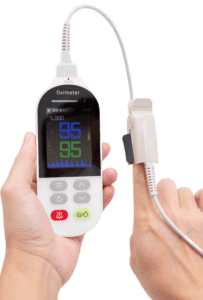
Sleep apnea is a common sleep disorder characterized by periodic pauses in breathing and reduced airflow during sleep. This condition can lead to serious health issues such as fatigue, cardiovascular diseases, and cognitive impairment. For individuals who suspect they may have sleep apnea, can hand-held pulse oximeters serve as an effective monitoring tool?
Handheld pulse oximeters are portable medical devices designed to measure blood oxygen saturation and heart rate. While typically regarded as tools for quick oxygen level checks, they can also be used to monitor the symptoms and severity of sleep apnea.
First and foremost, the convenience of hand-held pulse oximeters makes them an ideal choice for monitoring sleep apnea. These devices are compact, lightweight, and easily portable, allowing patients to use them at home or while on the go without disrupting their sleep. This provides convenience and flexibility for monitoring purposes.
Secondly, hand-held pulse oximeters are relatively cost-effective. Compared to traditional sleep monitoring devices, hand-held pulse oximeters are more affordable and accessible to a wider population. This affordability enables more patients to obtain these monitoring devices, enabling them to gain timely insights into their condition and take appropriate measures for treatment.
Furthermore, hand-held pulse oximeters offer comfort during use. They typically employ non-invasive sensor technology, requiring a gentle clip onto the patient’s fingertip to perform measurements without causing any discomfort or disturbance during sleep. This non-invasive design facilitates an easy and comfortable monitoring process, promoting patient acceptance and cooperation.
Hand-held pulse oximeters also feature alarm capabilities to alert patients and caregivers to take necessary action in case of any abnormal readings. When oxygen saturation or heart rate exceeds predetermined thresholds, the device triggers an alarm, ensuring prompt attention and intervention in potentially risky situations.
Additionally, hand-held pulse oximeters often come with data storage and recording capabilities. Patients can store monitoring data in the device’s internal memory or record it through applications connected to computers or mobile devices. This not only facilitates tracking and analysis of the patient’s condition for both the patient and healthcare providers but also provides valuable data for further diagnosis and treatment.
In summary, handheld pulse oximeters serve as convenient, cost-effective, comfortable, and feature-rich medical devices that can be valuable for monitoring sleep apnea. They offer portability, flexibility, monitoring alarms, and convenient data storage and recording. While hand-held pulse oximeters cannot replace specialized sleep monitoring devices, they are practical and reliable options for patients who require simple monitoring at home or for initial screening purposes.


